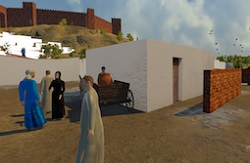Cultural heritage Virtual Reality brings us face to face with our ancestors
Virtual 3D scenes incorporating thousands of animated elements can be realistically rendered at fast frame rates, using current consumer-grade computers. Yet, despite opening up a range of possibilities for the leisure, security and education industries (to name but a few), one under-developed aspect remains that of crowd simulations which still comprise avatars displaying unrealistic behaviours. To increase the take-up of VR technology within the cultural heritage industry, the ‘Bio-inspired models of human crowds’ (BIHC) project used bio-mimicking techniques to improve crowd simulation techniques. Bringing together computer scientists and archaeology specialists resulted in a new Artificial Life model and associated authoring tool – a package known as ‘Easy-Population’ - to generate simulated autonomous and self-organising human populations. Enabling behavioural spontaneity in crowd simulations This EU-funded project emerged from previous investigations undertaken by the Marie Skłodowska-Curie action researcher Dr. Rui Filipe Antunes. He had examined Artificial Life systems known as Computational Ecosystem models, which emulate the organization of carbon-based life-forms. Dr. Antunes explains that, “I was interested in discovering how we could use these simulations for generating novelty, heterogeneity, and spontaneity.” The research underpinning the BIHIC crowd bio-mimicry is actually inspired by the work of psychologist Abraham Maslow, specifically his Theory of Motivation which establishes a hierarchy of human needs. As Dr. Antunes elaborates, “Gregariousness and nourishment are crucial to Maslow’s pyramid of needs and so the actions of BIHC avatars are motivated by these two factors, prompting the search for other individuals for social interaction or for trading. Actions and consequences are fed back into the system and so subsequently influence the avatars’ emotional states.” The Easy-Population authoring tool is available as a plugin on the game development platform Unity3d. The user provides static 3D models of the characters which function as templates for the population. Users then select the specifics of their required scenarios, such as number of individuals required or further details for the spatial location. The system then populates these scenarios. For the final case study, the project built a simulation of a neighbourhood in medieval Silves, in southern Portugal. Ancient buildings were modelled in 3D and the inhabitants animated to roam the space while performing their daily routines. As Dr. Antunes recalls, “This VR simulation was presented in the Silves castle to an audience of visiting tourists who, with the naked eye, could only see the new contemporary block of buildings. When these were built in 2007, work uncovered the remains of the past neighbourhood, now recreated in 3D. The experience was compelling to the visitors as they could travel back in time, bringing medieval life into the present day.” Getting out of the VR ghost town Effective simulations of the past allow us to better understand how ancient inhabitants could relate to, and interact with, their architectural context and each other. Yet past simulations have traditionally prioritised the recreation of physical spaces, devoid of habitation. “These spaces can seem more like ghost towns, very far from the vibrant living places that they are trying to represent. More research into the nuances of cultural representation is needed, since these are a critical part of the immaterial heritage of these sites,” Dr. Antunes summarises. Making the Easy-Population tool freely available at Unity3D’s asset store enables anyone with little or no knowledge of programming, to create an autonomous and self-organising simulation of human populations. The research has subsequently led to the founding of AnabiVirtual, a company which uses VR to enhance the museum experience for visitors, enabling them to become immersed in site representations as well as ‘meeting’ their ancient inhabitants.







